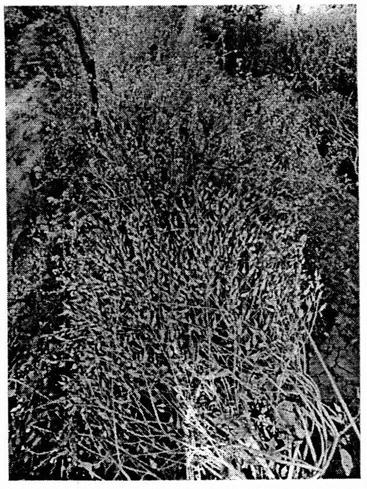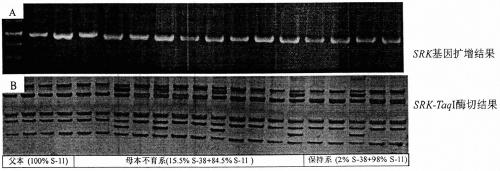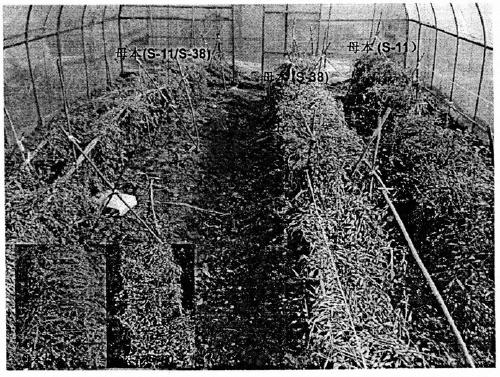A Method of Improving Seed Setting Rate of Radish Hybridization
A technology for radish hybridization and seed setting rate, which is applied in the fields of botany equipment and methods, biochemical equipment and methods, microbial measurement/inspection, etc., and can solve the problems of low radish hybrid seed setting rate, incompatibility reaction, and low flowering hybrid seed setting rate and other issues, to achieve good operability and application value, increase yield, and reduce the cost of seed production
- Summary
- Abstract
- Description
- Claims
- Application Information
AI Technical Summary
Problems solved by technology
Method used
Image
Examples
Embodiment 1
[0025] Example 1. Identification of the S haplotype of the parents of "Jinghong 3"
[0026] "Jinghong 3" is one of the new red-skinned radish varieties bred by the Vegetable Research Center of Beijing Academy of Agriculture and Forestry Sciences. It has the advantages of bright red fleshy root bark, white flesh, round root shape, strong disease resistance, and good cooked food quality. , suitable for autumn planting in North China and Northeast China. Only about 20% of the female parent plants of this variety produce seeds with male sterile lines (compatibility single plants), and the yield per mu is about 20 kg ( figure 1 ), the high cost of seed production restricts its further popularization and application. According to the analysis, it may be due to the incompatibility of hybridization caused by the same S haplotype in both parents, which caused the low seed setting rate of the hybrid. Therefore, it is necessary to identify the S haplotype of the parents.
[0027] (1) T...
Embodiment 2
[0033] Example 2, Development and Assisted Selection of S-11 and S-38 Haplotype Polymorphic Markers
[0034] Such as Figure 4 As shown, there is a difference of 9 bases in the above S-11 and S-38 haplotype SRK genes through DNAMAN software comparison, and contains the polymorphism Taq a I endonuclease cutting site (5'-AGCT-3'). According to the variation of this site, PCR-RFLP markers were developed for the screening of "Jinghong 3" hybrid affinity individual plants.
[0035] 300 strains of "Jinghong 3" male parent, male sterile line (female parent) and its maintainer line were respectively selected, and the above-mentioned PCR-RFLP markers were used for affinity single-plant screening. Such as figure 2 As shown, the S haplotypes of the male parents are all S-11, the individual plants of the S haplotype S-38 account for 15.5% of the female male sterile lines, and the individual plants of the S haplotype S-11 account for 84.5%. The individual plants with S haplotype S-38...
Embodiment 3
[0037] Embodiment 3, production test
[0038] In December 2015, molecular markers were used to select the female sterile line of "Jinghong 3", and the female parent plants with S haplotypes S-38, S-11 and S-11 / S-38 were selected respectively. 20 plants were planted in the same seed production shed with the male parent (S haplotype S11), and 2 honeybees were released at the initial flowering stage for a hybrid seed production experiment. Such as image 3 As shown, the number of pods of the female parent material with the S-38 haplotype was significantly more than that of the female parent material with the S haplotype S-11, and 40.3 g and 450.2 g of seeds were harvested respectively. It shows that the S haplotype of the parents of "Jinghong 3" can be significantly increased in hybrid seed production by using markers.
[0039] In the autumn of 2016, the "Jinghong 3" hybrids harvested from the S-haplotype S-38 and S-11 female parents were sown in the open field to test the authen...
PUM
 Login to View More
Login to View More Abstract
Description
Claims
Application Information
 Login to View More
Login to View More - R&D
- Intellectual Property
- Life Sciences
- Materials
- Tech Scout
- Unparalleled Data Quality
- Higher Quality Content
- 60% Fewer Hallucinations
Browse by: Latest US Patents, China's latest patents, Technical Efficacy Thesaurus, Application Domain, Technology Topic, Popular Technical Reports.
© 2025 PatSnap. All rights reserved.Legal|Privacy policy|Modern Slavery Act Transparency Statement|Sitemap|About US| Contact US: help@patsnap.com



